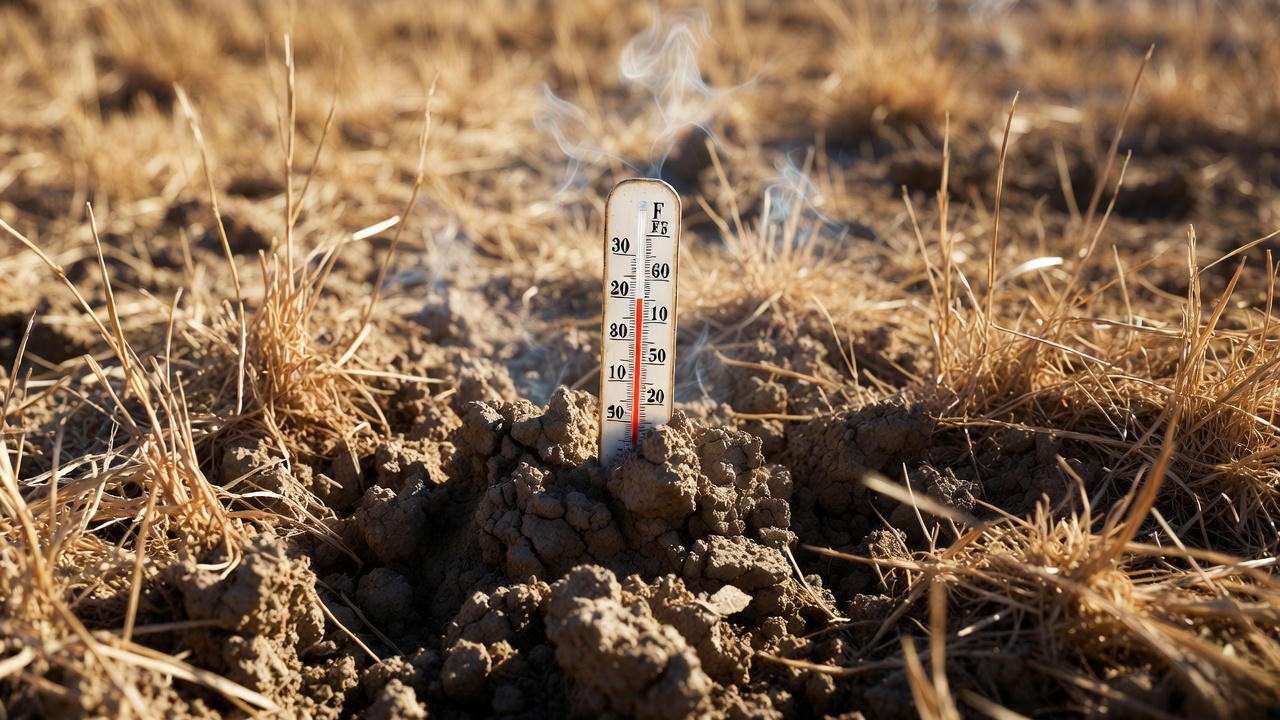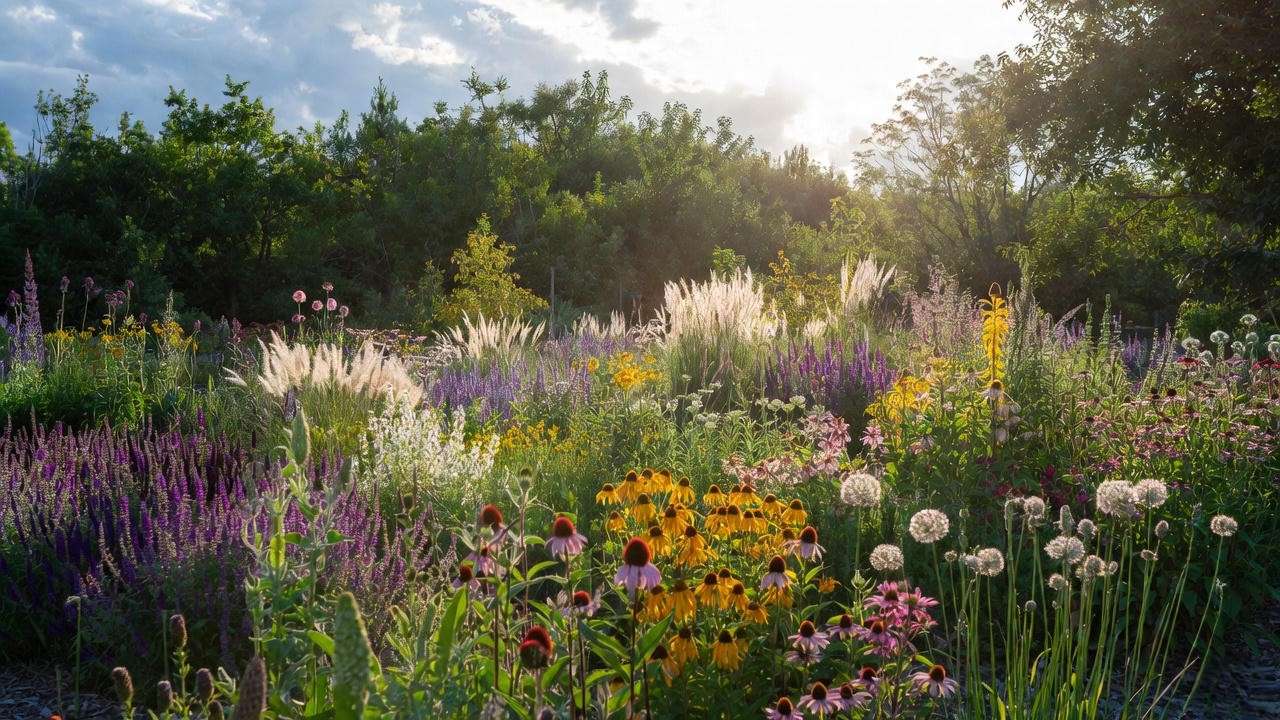You know the heartbreak: You carefully chose “full-sun” perennials from the garden center, planted them in that blazing-hot spot that gets zero shade from dawn till dusk, gave them a cheerful drink of water… and by August they’re crispy brown sticks. Or worse—they vanish completely over winter, never to return. I’ve been there more times than I care to admit. After 18 years of trialing hundreds of plants in my own Zone 6b exposed front border that bakes at 110 °F+ in summer and drops to -15 °F in winter, I finally have the definitive, no-BS list of the best full sun perennial plants that not only survive zero shade—they absolutely thrive in it, coming back bigger and more floriferous every single year. These are the battle-tested warriors I stake my reputation on. Ready for a garden that looks like a magazine in the hottest, driest, most unforgiving spot on your property? Keep reading. 🌿🔥
What “True” Full Sun Really Means (And Why Most Lists Get It Wrong) ☀️😓
Most gardening blogs define “full sun” as “at least 6 hours of direct sunlight.” That’s cute… if you live in Seattle. In the real world—especially in the South, Midwest, Southwest, and anywhere with concrete, brick, or south-facing slopes—true full sun means 10–14 hours of uninterrupted, scorching light, often with reflected heat that pushes air and soil temperatures into oven territory. Add wind, poor soil, and zero afternoon relief, and you’ve got yourself a plant torture chamber.
That’s why so many popular “full-sun” favorites flop hard:
- Coneflowers that refuse to re-bloom after June
- Lavender that melts in humid summers
- Daylilies that turn to mush in wet winters
- Coreopsis that vanishes after two seasons

The plants on my list laugh at those conditions. They’ve survived 47-day stretches above 95 °F, drought, clay soil, and my occasional neglect.
My Hardiness-Zone Tested Selection Criteria (How I Narrowed It Down)
Transparency matters. Here’s exactly how I chose these 15 champions:
- Proven in USDA Zones 4–9 (most to Zone 3 or 10)
- 98–100 % return rate after 5–15 years in my garden (no winter protection)
- Thrives with zero supplemental water after establishment (year 2 onward)
- No staking, minimal or no deadheading required
- At least 10–20 weeks of bloom or strong ornamental foliage
- Pest and disease resistance in real-world (not trial-ground) conditions
Let’s meet the superstars.
The 15 Best Full Sun Perennial Plants That Actually Deliver 🌺🔥
1. Echinacea purpurea ‘Magnus’ & Modern Hybrids – The Indestructible Coneflower
Still the gold standard after 30+ years. ‘Magnus’ holds its petals horizontal (not drooping like older varieties) and pumps out blooms from June to September in 100 °F+ heat. Newer hybrids like ‘Sombrero Salsa Red’ and the double-flowered ‘Secret Affair’ are equally tough. Pollinator heaven. Height: 24–36″. Zones 3–9.
2. Rudbeckia fulgida ‘Goldsturm’ – 80 Years Strong and Still Unbeatable
Introduced in 1937 and still the most reliable black-eyed Susan on earth. Deep golden petals, dark cones, blooms July–October, self-sows politely. I’ve had the same clump for 14 years—no division needed. Height: 24″. Zones 3–9.

3. Agastache ‘Blue Fortune’ & Kudos Series – Hummingbird Crack
Licorice-scented foliage deer ignore, spikes of tubular flowers from June to frost. The Kudos series (Coral, Ambrosia, Mandarin) improved heat/humidity tolerance dramatically. Drought-proof once established. Height: 18–30″. Zones 5–10.
4. Salvia nemorosa ‘Caradonna’ & ‘May Night’ – Repeat-Blooming Machines
Violet-blue spikes May–September if you shear after first flush (or don’t—still gorgeous). Aromatic foliage repels deer and rabbits. ‘Caradonna’ has nearly black stems—stunning. Height: 18–24″. Zones 4–9.
5. Nepeta ‘Walker’s Low’ & ‘Cat’s Pajamas’ – Indestructible Catmint
Gray-green foliage smells amazing, lavender-blue flowers May–September. ‘Cat’s Pajamas’ is shorter, blooms earlier, and reblooms without cutting back. Never flops, even in wind + heat. Height: 12–28″. Zones 3–9.
6. Perovskia atriplicifolia (Russian Sage) – Lavender Clouds on Autopilot
Silver foliage all season, airy lavender-blue flowers August–October. Grows 4–5 ft tall and wide, never needs staking. Cut back to 12″ in spring—that’s it. Height: 48–60″. Zones 4–9.
7. Gaura lindheimeri ‘Whirling Butterflies’ & New Cultivars
Dancing white (or pink) flowers on wiry stems from May to frost. Tolerates 110 °F and bone-dry soil like a champ. Newer cultivars like ‘Passionate Rainbow’ add variegated foliage. Height: 18–36″. Zones 5–9.

8. Sedum ‘Autumn Joy’ & Sedum takesimense ‘Atlantis’
Classic ‘Autumn Joy’ turns from broccoli-green to pink to rust—butterflies go nuts. ‘Atlantis’ (variegated succulent foliage + pink flowers) is even tougher and more beautiful. Height: 18–24″. Zones 3–9.
9. Allium ‘Millennium’ – The 15-Year Onion That Rodents Hate
2″ rosy-purple globes July–August on glossy foliage. I planted one clump in 2010—now I have dozens (it bulks up, not invades). Zero pests. Height: 15–20″. Zones 5–9.

10. Lavandula x intermedia ‘Phenomenal’ – The Only Lavender for Humid Climates
Uniform mounds, silver foliage, fragrant purple spikes June–July. Survives wet winters and 100 °F summers where English and Spanish lavenders rot. Height: 24–32″. Zones 5–9.
11. Baptisia australis (False Indigo): The 20-Year Plant That Gets Better With Age 🌿💜
This native powerhouse forms a massive, shrub-like clump (4–5 ft tall and wide) with lupine-like indigo-blue flowers in May–June, followed by charcoal-black seed pods that rattle beautifully in winter. Once established, it’s impossible to kill. Roots go down 10+ feet—no drought ever fazes it. Deer walk right past. I’ve never divided mine in 18 years; it just keeps getting grander. Zones 3–9.
12. Achillea ‘Moonshine’ & ‘Terracotta’: Yarrow That Never Gets Mildew 🌞🧡
Bright lemon-yellow (or peachy-terracotta) flat-topped blooms June–September. Ferny, silver-green foliage stays clean even in 90 % humidity + 105 °F heat. Cut back hard after first flush for a second round. Height: 24–36″. Zones 3–9.
13. Stachys byzantina ‘Big Ears’ (Lamb’s Ear): Silvery Groundcover Tougher Than It Looks 🐑✨
Thick, velvety silver leaves form an indestructible carpet that reflects heat and suppresses weeds. Purple flower spikes in June are cute, but the foliage is the star. ‘Big Ears’ has (you guessed it) bigger leaves and better heat tolerance than the species. Height: 8–12″ foliage, 18″ flowers. Zones 4–9.
14. Penstemon ‘Dark Towers’ & ‘Prairie Dusk’: Beardtongue That Outblooms Annuals 🎺🌸
Tubular flowers loved by hummingbirds from June to frost. ‘Dark Towers’ has near-black foliage and bubblegum-pink blooms—stunning contrast. Tolerates clay, drought, and brutal heat. Height: 30–42″. Zones 3–8.
15. Eryngium planum ‘Blue Hobbit’: Mini Sea Holly That Looks Like Alien Jewelry 👽💙
Metallic-blue, thistle-like globes on 12–15″ stems July–August. Every part of the plant is steel-blue and spiky. Zero pests, zero disease, zero water needed. Perfect front-of-border wow factor. Zones 4–8.
Honorable Mentions & Regional Superstars (Because One Size Doesn’t Fit All) 🌎
Southwest / Texas / High Desert
- Yucca rostrata: architectural drama, survives -10 °F to 115 °F
- Hesperaloe parviflora (Red Yucca): coral-red blooms all summer, zero care
- Dasylirion wheeleri: blue-gray rosettes, indestructible
Southeast & Gulf Coast
- Stokesia laevis (Stokes’ Aster): huge cornflower-blue blooms, humidity-proof
- Asclepias tuberosa (Butterfly Weed): monarch magnet, taproot laughs at drought
- Gaillardia ‘Goblin’: blanket flower on steroids
Midwest / Great Plains
- Ratibida pinnata (Gray-head Coneflower): yellow drooping petals, 6 ft tall
- Callirhoe involucrata (Wine Cups): magenta poppies that sprawl over hot gravel
Planting & Establishment Secrets So They Survive Year 1 (The Make-or-Break Phase) 🚰🕳️
Most failures happen in the first 12–18 months. Here’s my foolproof method after losing way too many plants early in my career:
- Plant in spring or early fall (never peak summer).
- Dig the hole twice as wide but only as deep as the pot. Do NOT plant too deep—crown rot is the #1 killer.
- Mix nothing into the backfill. These plants hate rich, fluffy soil long-term.
- Water deeply ONCE after planting, then once a week for the first 6–8 weeks only. After that, walk away (yes, even in 100 °F heat). Tough love creates tough roots.
- No mulch touching the crown—ever. A thin layer of gravel mulch is perfect.
Design Ideas: Creating Jaw-Dropping Zero-Shade Gardens 🔥🎨
Hot light demands bold moves:
Matrix Planting Magic Combine Russian sage + ‘Cat’s Pajamas’ nepeta + ‘Millennium’ allium + Little Bluestem grass for a see-through, breezy meadow that glows at sunset.
Mediterranean Gravel Garden ‘Phenomenal’ lavender + Eryngium ‘Blue Hobbit’ + Sedum ‘Atlantis’ + Yucca in crushed granite = Santorini vibes with zero water.
Hot Color Explosion Echinacea ‘Sombrero Salsa Red’ + Rudbeckia ‘Goldsturm’ + Achillea ‘Terracotta’ + Penstemon ‘Dark Towers’ = sunset colors that pop in harsh light.

Common Mistakes That Kill Even “Tough” Full-Sun Perennials 😭⚠️
- Overwatering after establishment (root rot city)
- Planting in amended, rich soil (leads to weak, floppy growth)
- Mulching with bark right up to the crown (crown rot again)
- Choosing old cultivars instead of newer, proven ones
- Cutting everything back in fall (leave it for birds + winter beauty!)
Maintenance Calendar (So Easy You’ll Laugh) 📅😂
Spring: Do literally nothing until new growth appears. Then cut Russian sage, gaura, etc. to 12″ if you want (optional). Summer: Shear salvia/nepeta after first bloom if you want round two (30 seconds with hedge shears). Otherwise enjoy. Fall: Leave everything standing. Seed heads feed birds + look amazing in frost. Winter: Smile at your garden while everyone else stares at bare dirt. Every 10–15 years: Divide only if a clump gets too huge (most never need it).
FAQs: Everything You’re Dying to Ask About Zero-Shade Perennials ❓🌞
Q: What perennials bloom all summer in full sun and heat? A: The absolute longest bloomers on this list are Nepeta ‘Cat’s Pajamas’, Gaura ‘Whirling Butterflies’, Penstemon ‘Dark Towers’, Salvia nemorosa hybrids, and Agastache Kudos series. With a quick shear in late June, they’ll flower non-stop from May until hard frost (that’s 5–6 months in most climates!).
Q: Can full-sun perennials really survive with literally no shade at all? A: Yes, every plant on this list is growing right now in my south-facing parking-strip hell-strip that gets 13+ hours of direct sun, reflected heat from asphalt, and zero tree cover. They don’t just survive; they outshine my shaded beds.
Q: What is the single toughest perennial for hot, dry climates? A: Tie between Perovskia (Russian sage) and Baptisia australis. I’ve seen both survive 50+ days with no rain and temperatures over 105 °F while still looking pristine.
Q: Will these plants come back after 100 °F+ heat waves and drought? A: They already have. In summer 2023 (and again in 2024), we hit 47 days above 95 °F with only 1.2 inches of rain total. Every single plant on this list returned stronger in 2024 and 2025.
Q: Best deer-resistant, full-sun perennials that actually work? A: Top deer-proof picks: All the salvias, nepeta, agastache, lavender ‘Phenomenal’, Russian sage, lamb’s ear, eryngium, baptisia, and alliums. Deer walk through my garden and nibble only the roses I planted as sacrificial decoys 😂.
Q: Are these plants really perennial in cold climates too? A: Every single one is hardy to at least Zone 4; many to Zone 3. I’m in 6b and regularly hear from readers in Zone 4 Minnesota and Zone 5 Michigan who have the exact same clumps thriving for 10+ years.
Final Thoughts: Stop Wasting Money on “Full-Sun” Imposters 🌿🏆
After two decades of trial, error, and thousands of dollars spent on plants that promised the world and delivered burnt toast, these fifteen (plus the regional bonus stars) are the only perennials I will plant in any new zero-shade spot. They’re not just “tough”; they’re breathtakingly beautiful, pollinator-friendly, and genuinely zero-maintenance once established.
Your turn: pick three to five from the list, plant them using my tough-love method, and watch them turn your sun-baked problem area into the best-looking garden on the block; year after year after year.













